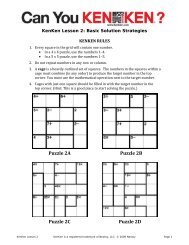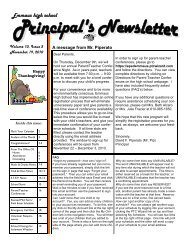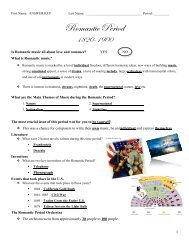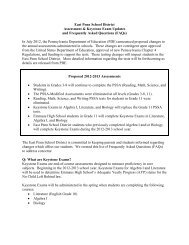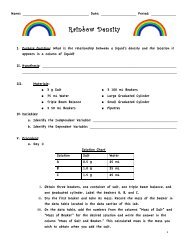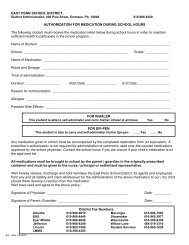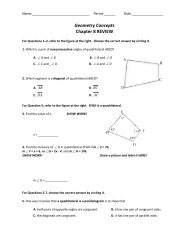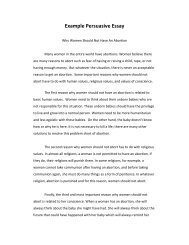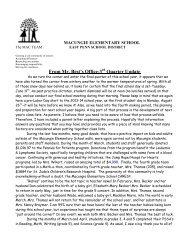Chapter 4 Trigonometric Functions
Chapter 4 Trigonometric Functions
Chapter 4 Trigonometric Functions
You also want an ePaper? Increase the reach of your titles
YUMPU automatically turns print PDFs into web optimized ePapers that Google loves.
<strong>Trigonometric</strong> <strong>Functions</strong><br />
c. θ = 180°= π radians<br />
The terminal side of the angle is on the negative<br />
x-axis. Select the point<br />
P = (–1,0): x =− 1, y = 0, r = 1<br />
Apply the definitions of the cosine and cosecant<br />
functions.<br />
x −1<br />
cos180°= cosπ<br />
= = =−1<br />
r 1<br />
r 1<br />
csc180°= csc π = = , undefined<br />
y 0<br />
d.<br />
3π<br />
θ = 270°= radians<br />
2<br />
The terminal side of the angle is on the negative<br />
y-axis. Select the point<br />
P = (0,–1): x = 0, y = − 1, r = 1<br />
Apply the definitions of the cosine and cosecant<br />
functions.<br />
3π<br />
x 0<br />
cos 270°= cos = = = 0<br />
2 r 1<br />
3π<br />
r 1<br />
csc 270°= csc = = =−1<br />
2 y −1<br />
3. Because sinθ<br />
< 0, θ cannot lie in quadrant I; all the<br />
functions are positive in quadrant I. Furthermore, θ<br />
cannot lie in quadrant II; sinθ is positive in quadrant<br />
II. Thus, with sinθ<br />
< 0, θ lies in quadrant III or<br />
quadrant IV. We are also given that cosθ < 0 .<br />
Because quadrant III is the only quadrant in which<br />
cosine is negative and the sine is negative, we<br />
conclude that θ lies in quadrant III.<br />
4. Because the tangent is negative and the cosine is<br />
negative, θ lies in quadrant II. In quadrant II, x is<br />
negative and y is positive. Thus,<br />
1 y 1<br />
tanθ =− = =<br />
3 x − 3<br />
x =− 3, y = 1<br />
Furthermore,<br />
2 2 2 2<br />
r = x + y = ( − 3) + 1 = 9+ 1=<br />
10<br />
Now that we know x, y, and r, we can find<br />
sinθ and secθ .<br />
y 1 1 10 10<br />
sinθ<br />
= = = ⋅ =<br />
r 10 10 10 10<br />
r 10 10<br />
secθ<br />
= = = −<br />
x −3 3<br />
5. a. Because 210° lies between 180° and 270°, it is<br />
in quadrant III. The reference angle is<br />
θ ′ = 210°− 180°= 30°.<br />
b. Because 7 π 3π<br />
6π<br />
lies between = and<br />
4<br />
2 4<br />
8π<br />
2π = , it is in quadrant IV. The reference<br />
4<br />
7π 8π 7π π<br />
angle is θ′ = 2π<br />
− = − = .<br />
4 4 4 4<br />
c. Because –240° lies between –180° and –270°, it<br />
is in quadrant II. The reference angle is<br />
θ = 240 − 180 = 60°.<br />
d. Because 3.6 lies between π ≈ 3.14 and<br />
3π ≈ 4.71 , it is in quadrant III. The reference<br />
2<br />
angle is θ′ = 3.6 −π<br />
≈ 0.46 .<br />
6. a. 665°− 360°= 305°<br />
This angle is in quadrant IV, thus the reference<br />
angle is θ′ = 360°− 305°= 55°.<br />
b.<br />
c.<br />
15 π 15 8 7<br />
− 2π<br />
= π − π =<br />
π<br />
4 4 4 4<br />
This angle is in quadrant IV, thus the reference<br />
7π 8π 7π π<br />
angle is θ′ = 2π<br />
− = − = .<br />
4 4 4 4<br />
11 11 12<br />
− π + 2⋅ 2π<br />
= − π + π =<br />
π<br />
3 3 3 3<br />
This angle is in quadrant I, thus the reference<br />
π<br />
angle is θ′ = .<br />
3<br />
7. a. 300° lies in quadrant IV. The reference angle is<br />
θ ′ = 360°− 300°= 60°.<br />
b.<br />
3<br />
sin 60°=<br />
2<br />
Because the sine is negative in quadrant IV,<br />
3<br />
sin 300°=− sin 60°=− .<br />
2<br />
5π lies in quadrant III. The reference angle is<br />
4<br />
5 5 4<br />
θ′ = π − π = π − π = π .<br />
4 4 4 4<br />
π<br />
tan = 1<br />
4<br />
Because the tangent is positive in quadrant III,<br />
5π<br />
π<br />
tan =+ tan = 1 .<br />
4 4<br />
518<br />
Copyright © 2010 Pearson Education, Inc. Publishing as Prentice Hall.



